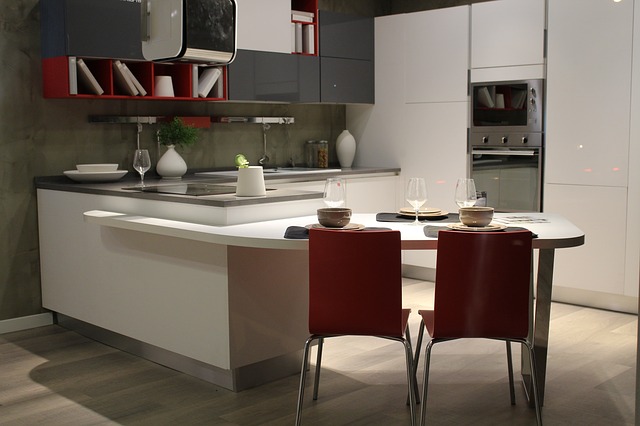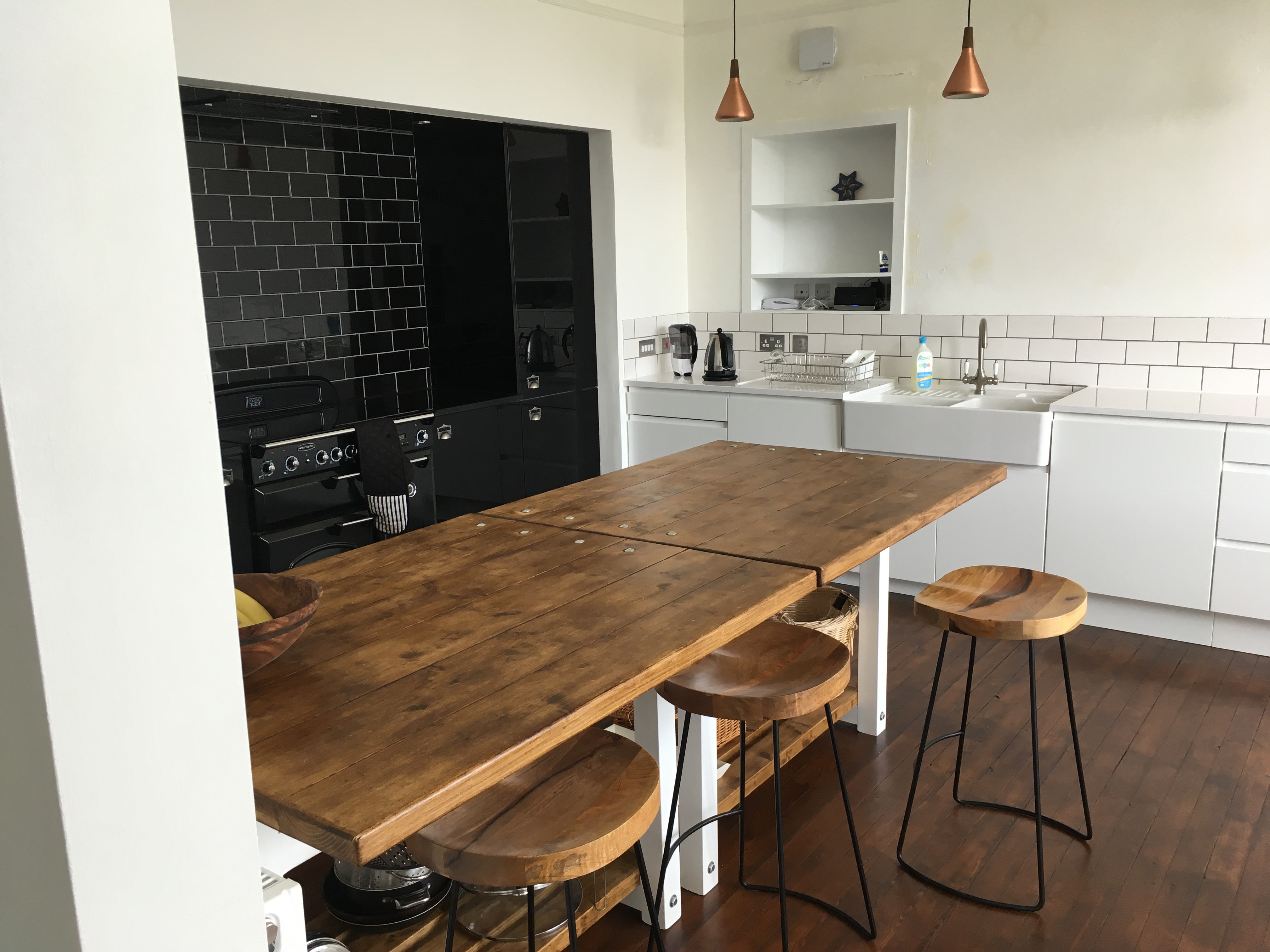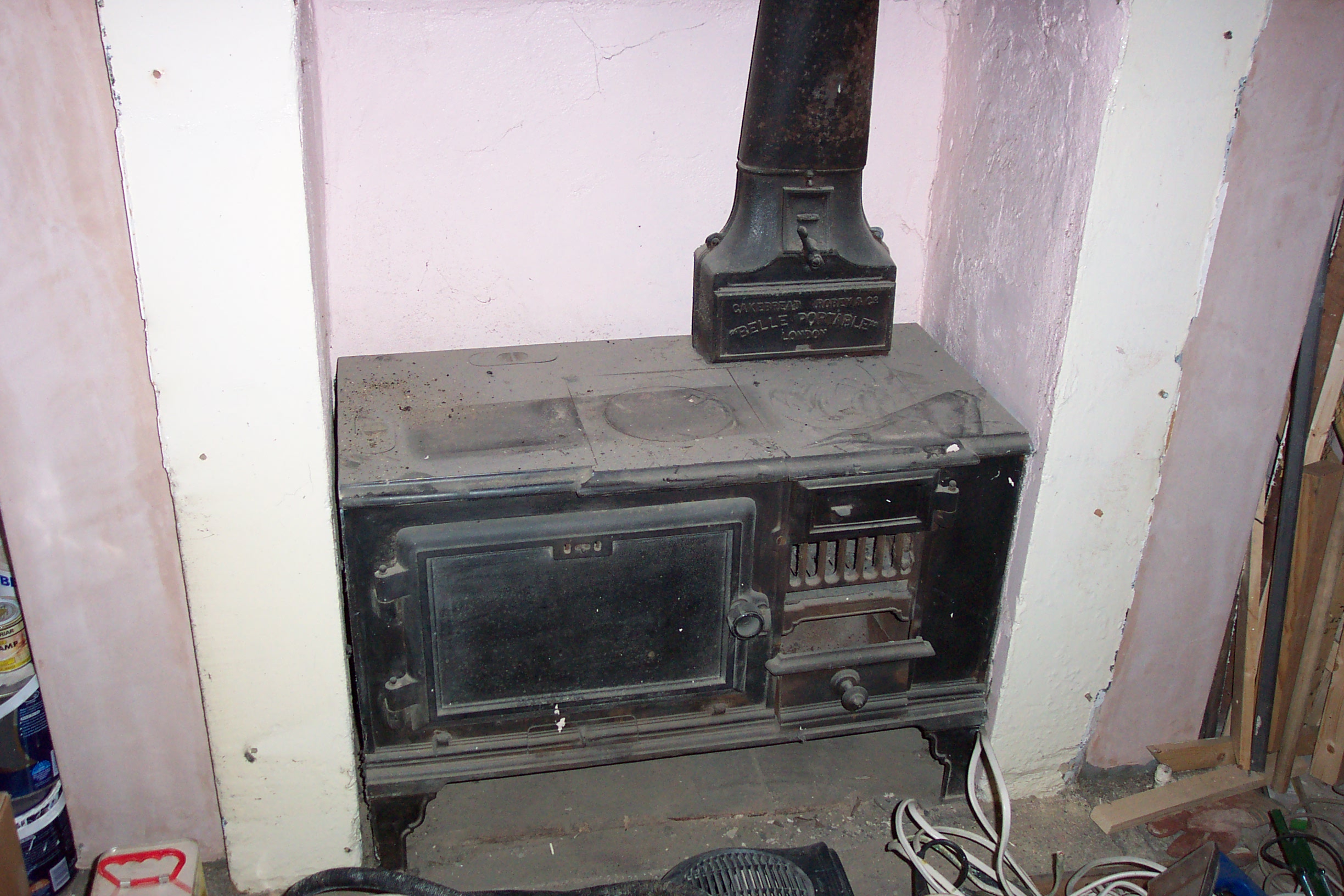Kitchen

|
| The 21st century kitchen. Image by Stefano Ferrario from Pixabay |
The kitchen is usually a room or designated area in a dwelling that is used for the storage and preparation of food and drinks. It will generally contain fixtures, fittings, equipment and implements for preparing, cooking and sometimes for eating snacks and meals, whether breakfast, lunch or dinner.
Historically, in the UK, the kitchen as a separate entity did not exist. This came about only when the pantry and buttery areas, usually found at the end of the Saxon hall house, were joined to become one area for preparing and cooking of food. This generally included a wide fireplace that allowed cooking on a spit.
The concept of a kitchen area used solely for the preparation of food continued through Elizabethan times into the Victorian era, during which it became a space that, in large houses, might be staffed by servants and hidden from public view. Many middle-class Victorian kitchens were situated below or partially below ground and were typically poorly lit and ventilated - but this meant that the associated storerooms and pantries were cool, if sometimes damp. In lower-class families, the kitchen was frequently the hub of family life, while for very poor households the idea of a separate kitchen was unknown – most of the cooking would have been done in the living room – the only room to have a fire.
The middle-class Victorian kitchen was generally simple and functional, with utensils, grill racks and pans hung in convenient places. The most important fitting however would have been the coal range used for cooking. Invented in the 1770s, it reigned supreme until it was superseded by gas and electricity in the early 20th century.
Typically, the range would consist of a coal fire within horizontal bars and a grate. Temperature control was provided crudely by opening various dampers and bypass flues. On one side of the range there might be a tank where water could be heated and stored.
The only other ‘fitted’ item in the Victorian kitchen would usually be the dresser with shelves for storing china, bread bin, utensils, table linen and other items. The white- or brown-glazed stoneware sink with its single cold tap would typically be located in the scullery. The only other item in the kitchen would be the table, usually in the centre, used for preparing food. Servant’s dining may have taken place in the kitchen, although the master and their family would have had a dining room on the upper floors.
A major shift in kitchen design occurred in the 1920s, when the kitchen became the domain not of servants but the housewife. Gas and electric cookers had become popular around the time of the First World War although they may have been awkwardly housed in small recesses. Further advances took place at the start of the 1930s when fitted cupboards began to appear. The sink would usually be the Belfast type and was one of the ‘centres of activity’ – the other two being the table and the stove.
The table top might have been covered either with an enamel sheet – to obviate the scrubbing that was needed with wooden Victorian tables – or with linoleum, both of which could be easily wiped clean. The Complete Home Book stressed that the table top should be positioned nine inches (225mm) below the elbow. At this point, the American concept of a continuous worktop had not reached the UK.
By the mid-1950s, the fashionable kitchen/diner came into being. This comprised a separate area for dining that was only sectioned off from the kitchen area by a screen comprising vertical timber panels and shelving. Larders were still common at this time (as were ice-boxes and meat safes) although they did not include a gas- or electric-powered refrigerator.
With the advent of larger, better-equipped kitchens in later 20th century houses, pantries, butteries, larders and sculleries became virtually obsolete. Today however, the pantry is enjoying a comeback in British and American homes. This is thought to be due to its practicality, homely charm and a nostalgia associated with bygone ages.
The 21st century kitchen – depending on size – is a flexible space which, apart from kitchen and dining functions, may also feature a wall-mounted TV, sofa and other items that allow it to function as a family and play room.

|
| A modern take on a Victorian kitchen. |
NB The Scottish Building Standards, Part I. Technical Handbook – Domestic, Appendix A Defined Terms, defines kitchen as: ‘…any room or part of a room used primarily for the preparation or cooking of food.’
Approved Document G, Sanitation, hot water safety and water efficiency, 2015 edition with 2016 amendments, defines a kitchen as: ‘…a room or part of a room which contains a sink and food preparation facilities.’
[edit] Related articles on Designing Buildings
- Dishwasher.
- Domestic building.
- Household.
- Hearth.
- Types of dwelling.
- Seven tips for designing a safe, efficient and comfortable family kitchen.
- Designing a small kitchen.
- Installing a kitchen.
- Kitchen lighting.
- Moores reveals the top five kitchen design trends for the housebuilding industry.
- Smart kitchen appliances.
- Stove.
Featured articles and news
Key points for construction at a glance with industry reactions.
Functionality, visibility and sustainability
The simpler approach to specification.
Architects, architecture, buildings, and inspiration in film
The close ties between makers and the movies, with our long list of suggested viewing.
SELECT three-point plan for action issued to MSPs
Call for Scottish regulation, green skills and recognition of electrotechnical industry as part of a manifesto for Scottish Parliamentary elections.
UCEM becomes the University of the Built Environment
Major milestone in its 106-year history, follows recent merger with London School of Architecture (LSE).
Professional practical experience for Architects in training
The long process to transform the nature of education and professional practical experience in the Architecture profession following recent reports.
A people-first approach to retrofit
Moving away from the destructive paradigm of fabric-first.
International Electrician Day, 10 June 2025
Celebrating the role of electrical engineers from André-Marie Amperè, today and for the future.
New guide for clients launched at Houses of Parliament
'There has never been a more important time for clients to step up and ...ask the right questions'
The impact of recycled slate tiles
Innovation across the decades.
EPC changes for existing buildings
Changes and their context as the new RdSAP methodology comes into use from 15 June.
Skills England publishes Sector skills needs assessments
Priority areas relating to the built environment highlighted and described in brief.
BSRIA HVAC Market Watch - May 2025 Edition
Heat Pump Market Outlook: Policy, Performance & Refrigerant Trends for 2025–2028.
Committing to EDI in construction with CIOB
Built Environment professional bodies deepen commitment to EDI with two new signatories: CIAT and CICES.
Government Grenfell progress report at a glance
Line by line recomendation overview, with links to more details.
An engaging and lively review of his professional life.
Sustainable heating for listed buildings
A problem that needs to be approached intelligently.
50th Golden anniversary ECA Edmundson apprentice award
Deadline for entries has been extended to Friday 27 June, so don't miss out!
CIAT at the London Festival of Architecture
Designing for Everyone: Breaking Barriers in Inclusive Architecture.
Mixed reactions to apprenticeship and skills reform 2025
A 'welcome shift' for some and a 'backwards step' for others.



























